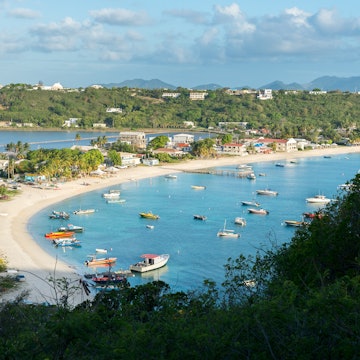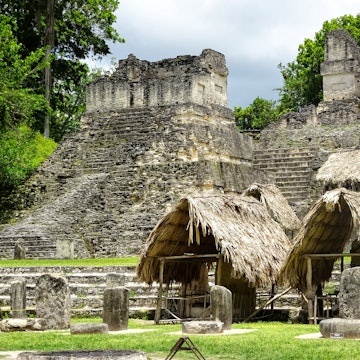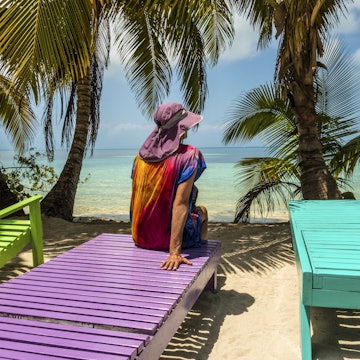

Belize City, Belize. Wirestock Creators/Shutterstock
Belize City is the capital of Belize District (and was the country capital until 1970), as well as the country’s largest population center. It gets a bad rap for its impoverished areas, but the seaside city also embodies Belize's amazing cultural diversity and historic past.
Just a few dozen miles from the light urban sprawl in several directions brings you to some pristine tropical environs, wildlife sanctuaries and seemingly remote rural countryside. Beyond, the Caribbean urbanism crumbles, revealing a landscape of vast savanna that stretches to the north, dense tropical forest to the west and lush marshland to the south.
Many visitors never set foot in this region beyond the international airport, but there’s enough to see and do in and around the city to easily fill a week, sampling the country’s Maya heritage, Creole culture and luxuriant wildlife.
These are the best things to do in Belize City.

1. Snorkel the Belize Barrier Reef
Goff’s Caye, a tiny speck of powder-white sand right on the barrier reef southeast of Belize City, is a nearby gem just 12 miles away. You’ll find some palms and a couple of palapa-covered (thatched-roofed) picnic tables, and the idyllic island offers good snorkeling and recently renovated amenities. It’s essentially a cruise-ship day trip, though, and minimum numbers are required to make the trip. Try Splash Wave Tours in Belize City.
Another great option is the lightly populated St George’s Caye, 7 miles south of Belize City. On September 10, 1798, British colonizers fought off invading Spaniards in the Battle of St George’s Caye, now celebrated as a national public holiday. Boat tours don’t visit here but you can stay at the luxurious St George’s Caye Resort or the more low-key six-bedroom Casa Almar Belize that sleeps eight to 16 guests. Without regular tours, dive boats or visiting cruise-ship passengers, St George’s feels like a private island for snorkeling or kayaking, but far humbler.
Detour: If scuba diving is more your style, head to the Great Blue Hole about 60 miles off the coast for a look at coral, tropical fish and stalactites.

2. Journey back in time
As the original British settlement and former capital, Belize City still holds remnants of the early days of British rule, and the modern Museum of Belize in the Fort George District provides an excellent overview of the story of Belize, through exhibits housed in the country’s former main jail (built in 1857). Fascinating displays, historical photos and documents bear testimony to the city's various eras, along with an exhibit on the history of enslaved people and a contemporary-art gallery. Upstairs is a gallery on the art of Belizean legend Pen Cayetano. Other sections are devoted to Belize’s coins, bottles and birdlife.
At the end of Regent St, opposite Government House (currently under construction), St John’s Cathedral is the oldest Anglican church in Central America. At the north end of Regent St, opposite Battlefield Park, the Court House (1926) is another impressive building, complete with clock tower and central exterior staircase. It still serves as the High Court of Belize.
Detour: Head a few blocks north to Bricks & Books Cafe, a charming downtown haunt housed in an original brick structure from the early 1800s with a bookstore upstairs.

3. See an array of rescued wild animals at Belize Zoo
If most zoos are maximum-security wildlife prisons, then Belize Zoo is more like a halfway house for wild, displaced or injured animals. It’s a good opportunity to see creatures you’re unlikely to see elsewhere – tapirs (a Belizean relative of the rhino), gibnuts, jaguars, coatimundis (they look like a cross between a raccoon and a monkey), scarlet macaws and many others.
What really sets Belize Zoo apart is that the zoo itself is relatively porous. This means that the wildlife you’ll see inside enclosures are outnumbered by creatures who have come in from the surrounding jungle to hang out and forage. Among the animals you’ll see wandering the grounds (aka “free runners”) are Central American agoutis (bush rabbits), iguanas, snakes, raccoons, squirrels and jungle birds. If you see a zookeeper, they’ll happily highlight the next best stop for that time of day.
For a special treat, book a night tour (many of the animals are nocturnal), arranging this via advance reservation.
Planning tip: Avoid the hot afternoon hours and visit early (from 8:30am) or late afternoon (from 3pm). On arrival, ask if your visit overlaps with feeding time for the tapirs (with carrots).

4. Sample the country’s famous beer
Belikin is Belize’s most iconic and best-known brand. Up there with Marie Sharp’s hot sauce, the “Beer of Belize” is everywhere in advertising, on billboards and in store fridges, bars and restaurants. The name is from a Maya word meaning “route to the East” and the label features a Maya temple from Altun Ha.
Belikin Brewery is just outside Belize City in Ladyville (behind the international airport). Along with the popular Belikin lager and stout, Belikin brews Lighthouse Lager, Landshark and a range of craft beers under the Two 5 label, including Coffee Lager, Valencia IPA and Bird Pepper Porter. The main reason to visit is for lunch or early dinner at the excellent Di Bruwry, a slick restaurant and bar within the brewery. As well as Belikin’s offerings on tap, the menu ranges from burgers and pizzas to tacos, burritos, chicken wings, steak and Belizean stewed chicken with rice and beans. Shiny steel brewing tanks form part of the backdrop behind the bar but the open-plan dining area peers into the brewery itself, with huge steel vats and pipes on show.
Planning tip: Contact the restaurant a day in advance to book a brewery tour for around 50 Belize dollars (BZ$) per person.

5. Explore Fort George
Walk 1.25 miles along the Caribbean seafront, and you’ll pass several local historical landmarks and attractions worth viewing. Start at the Museum of Belize for an excellent overview of Belizean history. Walk east along Goal Lane, past Celebrity Restaurant to the waterfront, and turn right on Marine Parade Blvd. It’s a couple of blocks to Fort George Memorial Park, dedicated to soldiers from WWI.
Continuing south, past the swanky Fort George Hotel, the road becomes Fort St, and here you’ll find the red-and-white Baron Bliss Lighthouse and Baron Bliss Tomb, the final resting place of Belize's most famous benefactor, who never set foot on Belizean soil while alive. There’s also a much-photographed Belize sign here and a small park across the road.
It's a short walk north to Fort Street Tourism Village, where you'll find a small collection of bars, restaurants and souvenir shops aimed at cruise-ship passengers. Look for murals showing Belizean life along the wall on Fort St. Further along is the terminal for the San Pedro water taxi service, which offers regular daily boats to Caye Caulker and San Pedro.
Along North Front St, call in for a coffee or a beer on the deck at the riverfront Spoonaz Photo Cafe and then walk to the landmark Swing Bridge over Haulover Creek, separating Fort George from Southside. This 1923 road bridge said to be the only remaining manually operated bridge of its type in the world. These days it’s rarely opened except to allow tall boats to pass before a serious storm, but it’s a good spot to photograph boats on the creek.
Planning tip: Belize City is small by city standards and easy to get around. The Fort George waterfront area is safe and entirely walkable. After dark, however, always take taxis and don’t go anywhere alone.


6. Goggle at manatees in Gales Point
Belonging to a unique group of sea mammals comprising only four species worldwide, manatees are thought to be distantly related to elephants. These amazing herbivores require huge amounts of vegetation each day, and graze on a wide variety of aquatic plants. (A large adult can process as much as 110lb every 24 hours, producing a prodigious amount of waste in the process.)
A great place to spot manatees is in remote Gales Point, 56 miles by road south of Belize City or 30 miles by boat. A fascinating Creole village founded around 1800 by runaway enslaved people from Belize City, the traditional enclave sits on a narrow peninsula that juts out about 3 miles into the Southern Lagoon, one of a series of interconnected lakes and waterways between Belize City and Dangriga that are home to the highest concentration of West Indian manatees in the Caribbean.
Manatees graze on sea grass in the shallow, brackish Southern Lagoon, hanging out around the Manatee Hole, a depression in the lagoon floor near its east side fed by a warm freshwater spring. The manatees rise about every 20 minutes for air, allowing spectators views of their heads and sometimes their backs and tails. A 1.5-hour manatee-watching boat trip costs around BZ$150 per person.
The main accommodation here, at the very northern tip of Gales Point, is Manatee Lodge, and the owners can arrange boat tours and kayaks for self-exploration on the lagoon.
Detour: You can also see manatees at Swallow Caye Wildlife Sanctuary; get there via private boat operators in Belize City.

7. Tour well-preserved Maya ruins
The Maya ruins that have inspired Belikin beer labels and Belizean banknotes, Altun Ha stands majestically 31 miles north of Belize City, off the Old Northern Hwy. While smaller and less imposing than some other Maya sites in the country, it's still spectacular and well worth the short detour to get here.
Altun Ha was a rich and important Maya trading and agricultural town with a population of 8000 to 10,000. It existed by at least 200 BCE, perhaps even several centuries earlier, and flourished until the mysterious collapse of the Classic Maya civilization around 900 CE. Most of the temples date from around 550 to 650 CE – though, like many Maya temples, most are composed of several layers, having been built over periodically in a series of renewals.
The original site covered 1500 acres, but what visitors see today is the central ceremonial precinct of two plazas surrounded by temples. Highlights include the Temple of the Green Tomb – in which archaeologists discovered the tomb of a priest-king dating from around 600 CE with many riches found intact – and the largest and most important temple, the Temple of the Masonry Altars (B-4), also known as the Temple of the Sun God. The restored structure dates from the first half of the 7th century CE and takes its name from altars on which copal was burned and beautifully carved jade pieces were smashed in sacrifice.
A path heading south from structure B-6 leads 600yd through the jungle to a broad pond that was the main reservoir of the ancient town. At the site entrance there is a small museum with informative displays covering the history of Altun Ha. Don’t miss the replica of the jade head of Maya sun god Kinich Ahau, the largest well-carved jade object ever recovered from a Maya archaeological site.
Planning tip: You can tour the site yourself, but it’s worth touring with a licensed guide (around BZ$20 per person) who you can find outside the museum building. They can show you details you might otherwise miss. Toilets, souvenir stands, and food and drink stalls are near the ticket office, and the site has good wheelchair access.

8. See a spectacular variety of birds
Crooked Tree, 35 miles northwest of Belize City, is a small secluded village surrounded by sublime lagoons, wetlands and the expansive Crooked Tree Wildlife Sanctuary. Between November and April, migrating birds flock to the sanctuary’s lagoons, rivers and swamps.
The best birdwatching is in April and May, when the low level of the lagoon draws thousands of birds into the open to seek food in the shallows, but at any time between December and May, birdwatchers will be in heaven. Some of the 300 species recorded here include boat-billed and bare-throated tiger herons, Muscovy and black-bellied whistling ducks, snail kites, ospreys, black vultures, black-collared hawks and all of Belize’s five species of kingfisher. Jabiru storks, the largest flying bird in the Americas, congregate here year-round.
At the village entrance, just off the causeway, stop by the Visitor Center to browse the interesting displays and pay your one-off admission fee, which is valid for as long as you stay in the village. The helpful, knowledgeable staff will provide a village and trail map for self-guided exploration, as well as information on local bird guides.
Planning tip: In the village of Crooked Tree, you can find half a dozen lodges, most of which can arrange lagoon boat tours. Bird’s Eye View Lodge, on the lagoon south of the causeway, offers a 2–3-hour birding boat cruise, sunset cruise and crocodile-spotting night safari, as well as guided nature walks.
This article was adapted from Lonely Planet’s Central America guidebook, published in October 2025.













